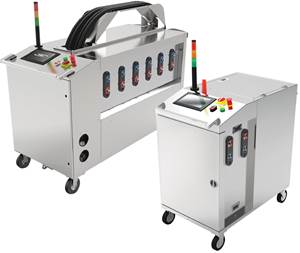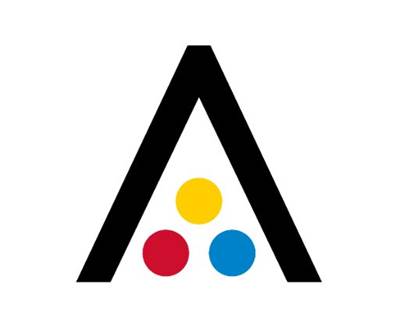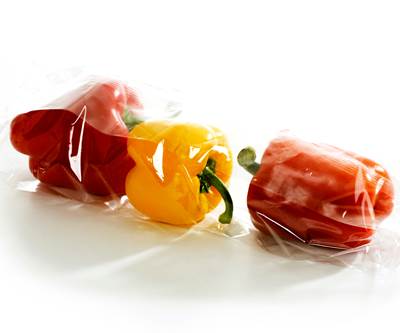BOPE Takes Aim at BOPP & BOPET Films
Nova’s new biaxially oriented HDPE is seen as a more easily recyclable monomaterial contender versus multilayer BOPP or BOPET films.
Within the last couple of years, biaxially oriented polyethylene (BOPE) has emerged as a major potential contender in packaging designed for recyclability. As is the case with the longer-running trend of all-PE blown-film packaging (e.g., standup pouches), the drivers for this monomaterial option are sustainability and the circular economy. Nova Chemicals is among the companies leading in development of BOPE.
At the 2019 K show in Düsseldorf, SABIC launched a new LLDPE for BOPE films. The company showed examples of BOPE standup pouches suitable for confectionary and snacks; frozen, fresh and dried fruit and vegetables; and packaging for personal-care products. BOPE boasts good printability, high mechanical properties and toughness, as well as very high seal integrity. SABIC’s new material also enables BOPE film to provide controlled, linear tear direction, thus making the package easy to open.
More recently, Nova has collaborated with several organizations across the supply chain to develop monomaterial BOPE packaging, focusing on a particularly pressing market need for bi-oriented HDPE (HD-BOPE) for the tenter-frame process to replace multimaterial packaging based on bi-oriented polypropylene (BOPP) or PET (BOPET).
Nova says HD-BOPE packaging is more easily recyclable and can enable higher recycling rates for flexible packaging and help brand owners achieve their circular-economy commitments. While BOPP has a decades-long head start in bi-oriented films, HD-BOPE has potential to become an industry standard for recyclable packaging over the next several years, according to Owen Lightbody, technical service’s team leader for performance films.
Optimized HDPE
The tenter-frame process used to bi-orient films is very demanding, and most of the equipment in place today has been designed around PP, PET and nylon, Nova experts explain. While LLDPE can easily be stretched, films made with it lack the stiffness and heat resistance required for most high-performance applications, which can be achieved with HDPE. As such, Nova views HDPE as the more desirable material for BOPE film, though conventional HDPE also presents a major challenge—a lack of elasticity to be stretched to any great extent.
Now, Nova Chemicals has developed HDPE grades specifically for the biaxially oriented film process, improving the production of HD-BOPE films, which the company believes will enable game-changing opportunities to create monomaterial packaging suited to a circular economy.
Two film designs are already receiving considerable market interest. The first is a 100% HDPE print web, and the second is a sealant film. The sealant film provides low seal-initiation temperatures on a packaging line without sticking to any rollers on the tenter-frame line.
“We’re seeing a high level of interest and activity in HD-BOPE across multiple global regions, and we anticipate a rapid expansion of these films in many packaging segments. We also expect oriented LLDPE films to grow in the next few years due to performance advantages over conventional blown and cast films. As the flexible packaging industry pursues monomaterial packaging solutions, LLD-BOPE is well positioned to replace cast PP, BOPET and BOPA (bi-oriented nylon) in many applications,” says Lightbody.
Processing Challenges
While the profile of BOPE has been elevated by the combination of sustainability commitments made by brand owners and the attractiveness of monomaterial packaging for enhanced recyclability, the reality is that the supply chain is mainly equipped with legacy tenter-frame lines designed around PP. The primary challenge is developing HDPE technology that has a suitable orientation window to be processed on these existing tenter frames.
“We’re seeing a high level of interest and activity in HD-BOPE across multiple global regions, and we anticipate a rapid expansion of these films in many packaging segments.”
Nova collaborated with leading tenter-frame machine builder Brueckner Group to optimize HDPE resin technologies for BOPE and accelerate the commercialization of HD-BOPE films. Areas of focus were extrusion output and achieving reliable production with no film breaks. Continued improvement in output rates will be achieved through a combination of novel PE resin architecture and equipment optimization such as Brueckner’s novel BOPP/BOPE hybrid tenter-frame design.
Highly specialized resins that offer a tailored viscosity profile for the tenter-frame process, extremely low gels, and lot-to-lot consistency are required for processing defect-free films, according to Nova experts.
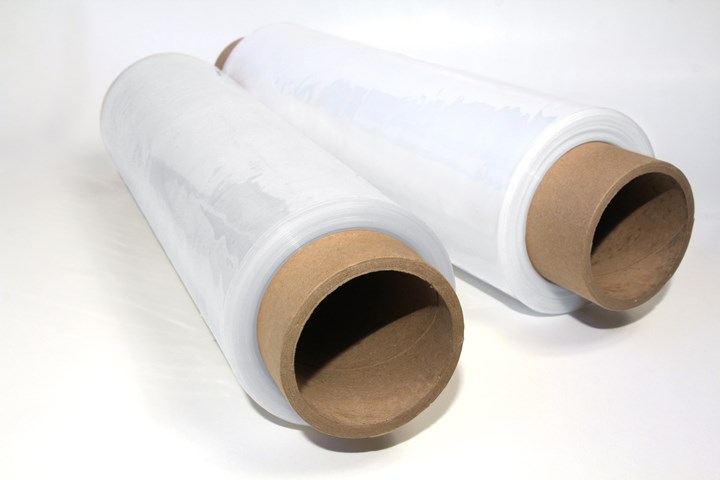
HD-BOPE has potential for becoming industry standard for recyclable films.
Advantages Over BOPET, BOPP
The number and complexities of the different applications using BOPP, BOPET and/or BOPA (biaxially oriented nylon) are sizable and completely replacing them with BOPE would be unrealistic. Nonetheless, there are many packaging segments where a BOPE option is advantageous from a performance and/or circular-economy perspective. The most significant benefit of BOPE over alternative materials is easier recyclability. Polypropylene is typically more difficult to recycle due to lack of recycling streams in some world regions, including much of North America, and many BOPP-containing structures and applications are multimaterial. HD-BOPE could thus be an important innovation for the widespread adoption of monomaterial recyclable packaging.
More broadly, many traditional flexible packages are composed of mixed-material laminates such as PET/PE to deliver the required performance such as stiffness, heat resistance and seal performance. Due to the wide range of PE product densities, PE can meet a wide range of performance requirements. Lower-density materials such as LLDPE exhibit outstanding seal properties, while higher-density PE materials provide stiffness and heat resistance. HD-BOPE results in stiffer films that enable downgauging, as well as low tear properties to create easy-open packaging, and a dramatic enhancement of optical properties, which improve the package’s shelf appeal compared with standard HDPE. Nova also has several LLD-BOPE grades and can work with processors to design HD-BOPE/LLD-BOPE monomaterial laminate films.
Sidebar:
Nova Chemicals Industry Collaborations
Recognizing the need for HD-BOPE in the marketplace, Nova Chemicals sought out industry leaders and partners, including:
▪ Toray Plastics America Inc., Providence, R.I., whose film manufacturing expertise and knowledge of oriented films in packaging applications was very valuable in developing HD-BOPE technology, according to Lightbody. Toray Plastics has been a leading manufacturer of PET, PP, biobased, and metalized films for flexible and rigid packaging, lidding, and graphic, industrial, optical, and electronic applications. Nova and Toray jointly conducted pilot-line trials, which provided instant feedback on processing and orientability of various HDPE resin candidates, and evaluated the resulting film performance. This collaborative approach helped Nova Chemicals to optimize its resins for HD-BOPE.
▪ Brueckner, a leading tenter-frame OEM, and Portugal’s major film manufacturer Polivouga. Together they have evaluated a number
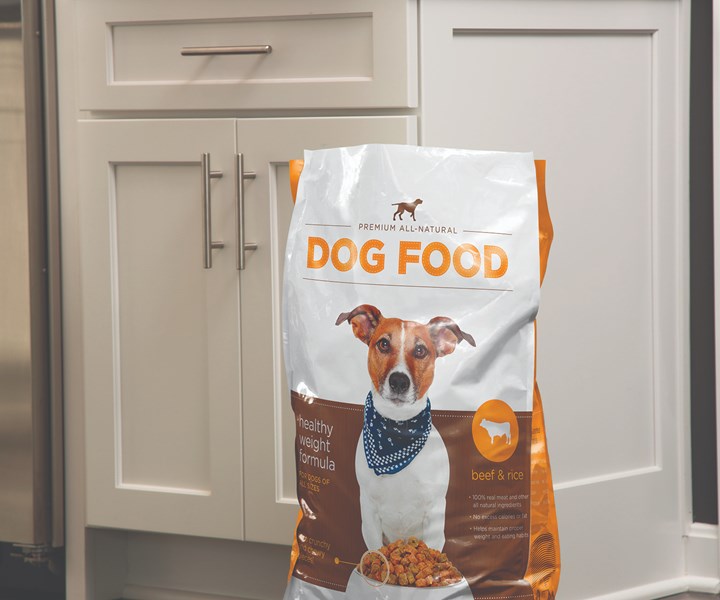
HD-BOPE offers a monomaterial alternative to multilayer BOPP or BOPET..
of HDPE resins for biaxial stretching on pilot lines at Brueckner’s facility and on a commercial line in Portugal. Both Nova and Brueckner view BOPE as a promising circular-economy building block, providing another solution for the industry to reach the target of 100% recyclable packaging.

Another potential application for BOPE.
Related Content
PHA Compound Molded into “World’s First” Biodegradable Bottle Closures
Beyond Plastic and partners have created a certified biodegradable PHA compound that can be injection molded into 38-mm closures in a sub 6-second cycle from a multicavity hot runner tool.
Read MoreSystem Offers 'Lights Out' Mold-Channel Cleaning & Diagnostics
New system automatically cleans mold-cooling lines—including conformal channels—removing rust and calcium, among other deposits, while simultaneously testing for leaks, measuring flow rate and applying rust inhibitor.
Read MoreExtrusion Technology Extended to Injection, Enabling Up to 100% Regrind Usage
Twin-barrel (shot-pot) press can handle more regrind, offers other benefits to molders.
Read MoreMasterbatch Creates Cavities, Helping Film Processors Boost Sustainability, Recyclability
Additive technology creates air pockets in film during orientation, cutting down on the amount of resin needed while boosting opacity, mechanical properties and recyclability.
Read MoreRead Next
‘Circular Economy’ Will Be Unifying Theme at K 2019 Show
Even injection machine suppliers like Engel will talk about ways their technology can support recycling.
Read MoreAdditives: Additive and White Masterbatch Portfolio for BOPE Films
Ampacet’s Biox4ce additive masterbatches for biaxially-oriented polyethylene (BOPE) film applications support the circular economy.
Read MorePlastic Food Packaging and Sustainability During COVID-19
Bob Maughon, executive vice president, technology & innovation for SABIC, discusses the role of plastic food packaging and sustainability in light of today’s public health climate.
Read More
























